Ultrasound-Assisted Activated Carbon Adsorption Au(CN)2−
Abstract
:1. Introduction
2. Experimental
2.1. Materials
2.2. Preparation of Au(CN
2.3. Adsorption Experiments
2.4. Characterization of Samples
3. Results and Discussion
3.1. Effect of Ultrasonic Device
3.2. Effect of Initial pH
3.3. Effect of Activated Carbon Dosage
3.4. Effect of CN− Concentration
3.5. Adsorption Isotherm
3.6. Adsorption Kinetics
3.7. Mechanism of Ultrasonic Enhanced Adsorption
4. Conclusions
Author Contributions
Funding
Institutional Review Board Statement
Informed Consent Statement
Data Availability Statement
Conflicts of Interest
References
- Xia, J.S.; Mahandra, H.; Ghahreman, A. Efficient Gold Recovery from Cyanide Solution Using Magnetic Activated Carbon. ACS Appl. Mater. Interfaces 2021, 13, 47642–47649. [Google Scholar] [CrossRef] [PubMed]
- Sitando, O.; Senanayake, G.; Dai, X.; Breuer, P. The adsorption of gold(I) on minerals and activated carbon (preg-robbing) in non-ammoniacal thiosulfate solutions—Effect of calcium thiosulfate, silver(I), copper(I) and polythionate ions. Hydrometallurgy 2019, 184, 206–217. [Google Scholar] [CrossRef]
- Figueroa Martinez, G.V.; Parga Torres, J.R.; Valenzuela García, J.L.; Tiburcio Munive, G.C.; González Zamarripa, G. Kinetic Aspects of Gold and Silver Recovery in Cementation with Zinc Power and Electrocoagulation Iron Process. Adv. Chem. Eng. Sci. 2012, 2, 342–349. [Google Scholar] [CrossRef]
- Gámez, S.; Garcés, K.; Torre, E.; Guevara, A. Precious metals recovery from waste printed circuit boards using thiosulfate leaching and ion exchange resin. Hydrometallurgy 2019, 186, 1–11. [Google Scholar] [CrossRef]
- Xu, W.; Zhou, S.; Wang, B.; Zhang, P.; Tang, K. Efficient adsorption of Au(III) from acidic solution by a novel N, S-containing metal–organic framework. Sep. Purif. Technol. 2022, 288, 120646. [Google Scholar] [CrossRef]
- Yang, L.; Jia, F.; Yang, B.; Song, S. Efficient adsorption of Au(CN from gold cyanidation with graphene oxide-polyethylenimine hydrogel as adsorbent. Results Phys. 2017, 7, 4089–4095. [Google Scholar] [CrossRef]
- Wang, C.; Lin, G.; Zhao, J.; Wang, S.; Zhang, L. Enhancing Au(III) adsorption capacity and selectivity via engineering MOF with mercapto-1,3,4-thiadiazole. Chem. Eng. J. 2020, 388, 124211. [Google Scholar] [CrossRef]
- Wang, F.; Xu, W.; Zhang, K.; Tang, K. Efficient and selective adsorption of Au(III) and Pd(II) by trimesoyl chloride-crosslinked polyethyleneimine. React. Funct. Polym. 2022, 178, 105360. [Google Scholar] [CrossRef]
- Wang, C.W.; Chen, S.L.; Chen, Y.L.; Zi, F.T.; Hu, X.Z.; Qin, X.C.; Zhang, Y.; Yang, P.; He, Y.; He, P.Q.; et al. Modification of activated carbon by chemical vapour deposition through thermal decomposition of thiourea for enhanced adsorption of gold thiosulfate complex. Sep. Purif. Technol. 2020, 241, 116632. [Google Scholar] [CrossRef]
- Ramírez-Muñiz, K.; Song, S.; Berber-Mendoza, S.; Tong, S. Adsorption of the complex ion Au(CN onto sulfur-impregnated activated carbon in aqueous solutions. J. Colloid Interface Sci. 2010, 349, 602–606. [Google Scholar] [CrossRef]
- Zhang, W.; Liang, Y.; Wang, J.; Zhang, Y.; Gao, Z.; Yang, Y.; Yang, K. Ultrasound-assisted adsorption of Congo red from aqueous solution using MgAlCO3 layered double hydroxide. Appl. Clay Sci. 2019, 174, 100–109. [Google Scholar] [CrossRef]
- Daware, G.B.; Gogate, P.R. Removal of pyridine using ultrasound assisted and conventional batch adsorption based on tea waste residue as biosorbent. Environ. Technol. Innov. 2021, 21, 101292. [Google Scholar] [CrossRef]
- Jing, G.; Zhou, Z.; Song, L.; Dong, M. Ultrasound enhanced adsorption and desorption of chromium (VI) on activated carbon and polymeric resin. Desalination 2011, 279, 423–427. [Google Scholar] [CrossRef]
- Gao, X.; Liu, J.; Li, M.; Guo, C.; Long, H.; Zhang, Y.; Xin, L. Mechanistic study of selective adsorption and reduction of Au (III) to gold nanoparticles by ion-imprinted porous alginate microspheres. Chem. Eng. J. 2020, 385, 123897. [Google Scholar] [CrossRef]
- Wang, J.; Guo, X. Rethinking of the intraparticle diffusion adsorption kinetics model: Interpretation, solving methods and applications. Chemosphere 2022, 309 Pt 2, 136732. [Google Scholar] [CrossRef]
- Groszek, A.J.; Partyka, S.; Cot, D. Heats of adsorption of gold chloride and cyanide complexes from aqueous solutions on graphitized carbon black and a coconut active carbon. Carbon 1991, 29, 821–829. [Google Scholar] [CrossRef]
- Gahrouei, A.E.; Rezapour, A.; Pirooz, M.; Pourebrahimi, S. From classic to cutting-edge solutions: A comprehensive review of materials and methods for heavy metal removal from water environments. Desalin. Water Treat. 2024, 319, 100446. [Google Scholar] [CrossRef]
- Lin, G.; Hu, T.; Wang, S.; Xie, T.; Zhang, L.; Cheng, S.; Fu, L.; Xiong, C. Selective removal behavior and mechanism of trace Hg(II) using modified corn husk leaves. Chemosphere 2019, 225, 65–72. [Google Scholar] [CrossRef]
- Feng, B.; Yao, C.; Chen, S.; Luo, R.; Liu, S.; Tong, S. Highly efficient and selective recovery of Au(III) from a complex system by molybdenum disulfide nanoflakes. Chem. Eng. J. 2018, 350, 692–702. [Google Scholar] [CrossRef]
- Saman, N.; Rashid, M.U.; Lye, J.W.P.; Mat, H. Recovery of Au(III) from an aqueous solution by aminopropyltriethoxysilane-functionalized lignocellulosic based adsorbents. React. Funct. Polym. 2018, 123, 106–114. [Google Scholar] [CrossRef]
- Sedira, N.; Bouranene, S.; Gheid, A. Ultrasound-assisted adsorption of Pb ions by carbonized/activated date stones from singles/mixed aqueous solutions. J. Indian Chem. Soc. 2022, 99, 100318. [Google Scholar] [CrossRef]
- Adebisi, G.A.; Chowdhury, Z.Z.; Alaba, P.A. Equilibrium, kinetic, and thermodynamic studies of lead ion and zinc ion adsorption from aqueous solution onto activated carbon prepared from palm oil mill effluent. J. Clean. Prod. 2017, 148, 958–968. [Google Scholar] [CrossRef]
- Egbosiuba, T.C.; Abdulkareem, A.S.; Kovo, A.S.; Afolabi, E.A.; Tijani, J.O.; Auta, M.; Roos, W.D. Ultrasonic enhanced adsorption of methylene blue onto the optimized surface area of activated carbon: Adsorption isotherm, kinetics and thermodynamics. Chem. Eng. Res. Des. 2020, 153, 315–336. [Google Scholar] [CrossRef]
- Niu, H.; Volesky, B. Gold adsorption from cyanide solution by chitinous materials. J. Chem. Technol. Biotechnol. 2001, 76, 291–297. [Google Scholar] [CrossRef]
- Alaei, R.; Javanshir, S.; Behnamfard, A. Treatment of gold ore cyanidation wastewater by adsorption onto a Hydrotalcite-type anionic clay as a novel adsorbent. J. Environ. Health Sci. Eng. 2020, 18, 779–791. [Google Scholar] [CrossRef]
- Swantomo, D.; Faturrahman, I.R.; Basuki, K.T.; Wongsawaeng, D. Chitosan-polyacrylamide graft copolymers prepared with gamma irradiation for gold cyanide adsorption. Polym.-Plast. Technol. Mater. 2020, 59, 1284–1291. [Google Scholar] [CrossRef]
- Ok, Y.S.; Jeon, C. Selective adsorption of the gold–cyanide complex from waste rinse water using Dowex 21K XLT resin. J. Ind. Eng. Chem. 2014, 20, 1308–1312. [Google Scholar] [CrossRef]
- Xia, J.; Marthi, R.; Twinney, J.; Ghahreman, A. A review on adsorption mechanism of gold cyanide complex onto activation carbon. J. Ind. Eng. Chem. 2022, 111, 35–42. [Google Scholar] [CrossRef]
- Belwal, T.; Li, L.; Yanqun, X.; Cravotto, G.; Luo, Z. Ultrasonic-assisted modifications of macroporous resin to improve anthocyanin purification from a Pyrus communis var. Starkrimson extract. Ultrason. Sonochem. 2020, 62, 104853. [Google Scholar] [CrossRef]
- Yu, Q.; Fan, L.; Li, J. A novel process for asparagus polyphenols utilization by ultrasound assisted adsorption and desorption using resins. Ultrason. Sonochem. 2020, 63, 104920. [Google Scholar] [CrossRef]




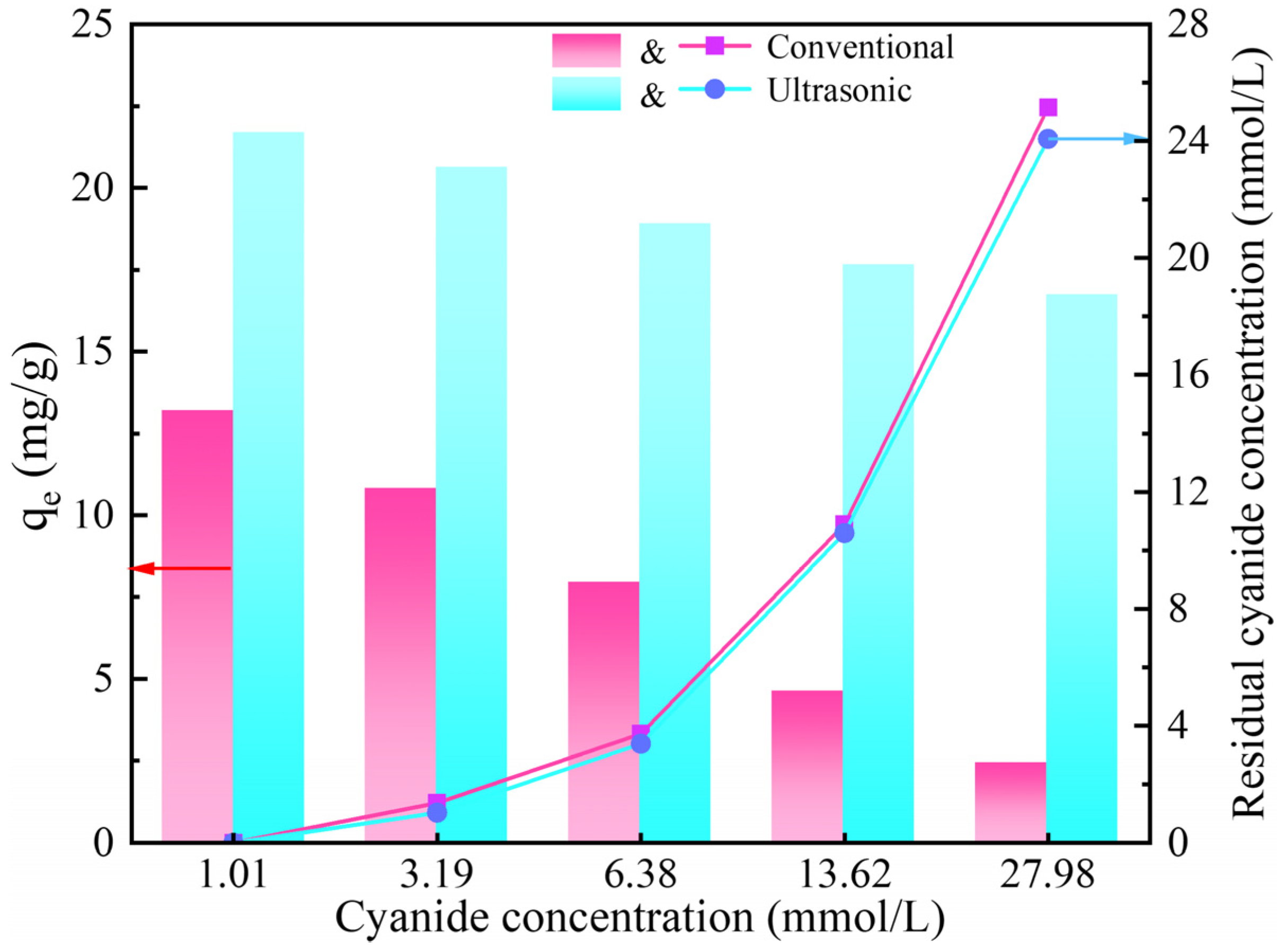
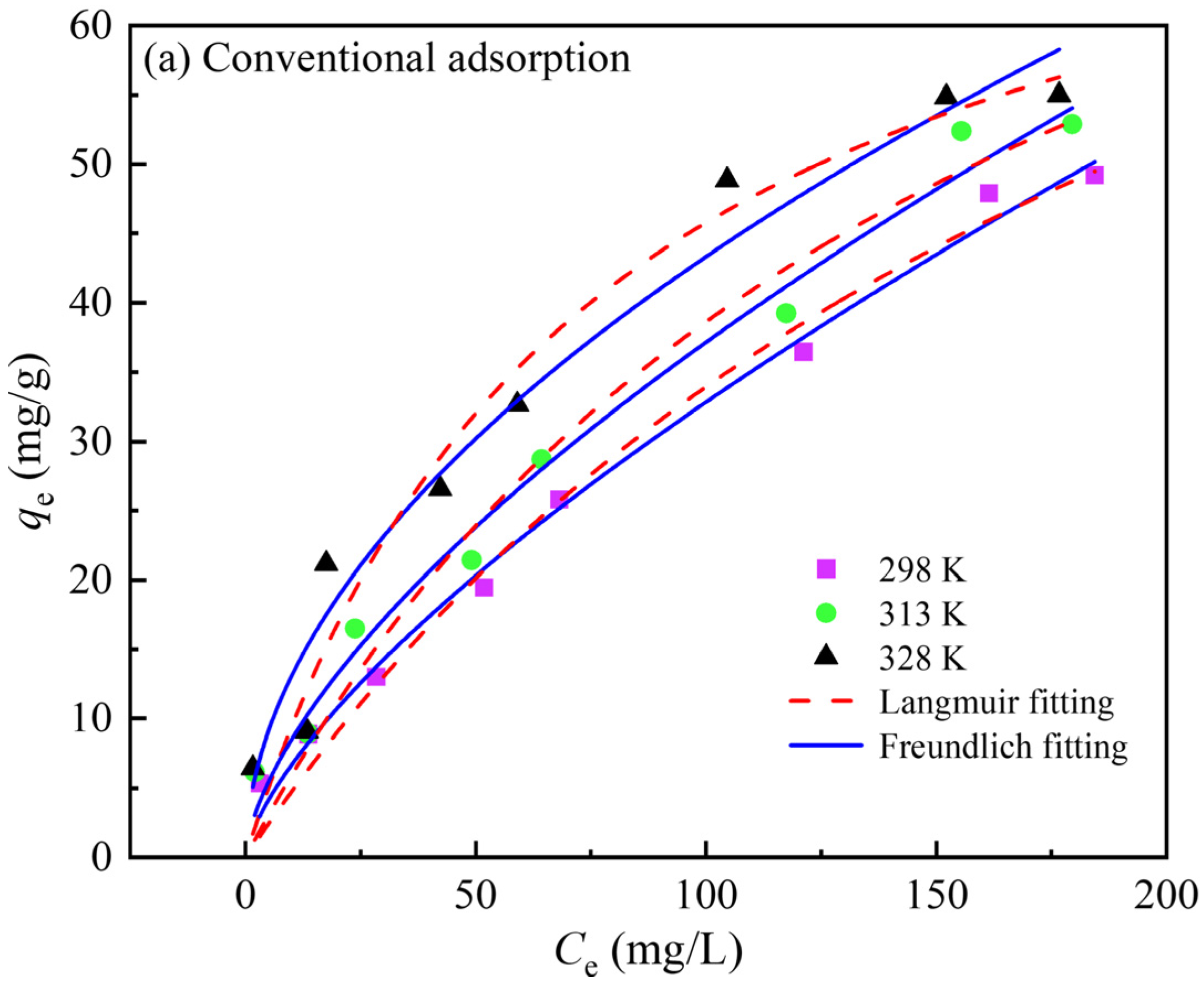
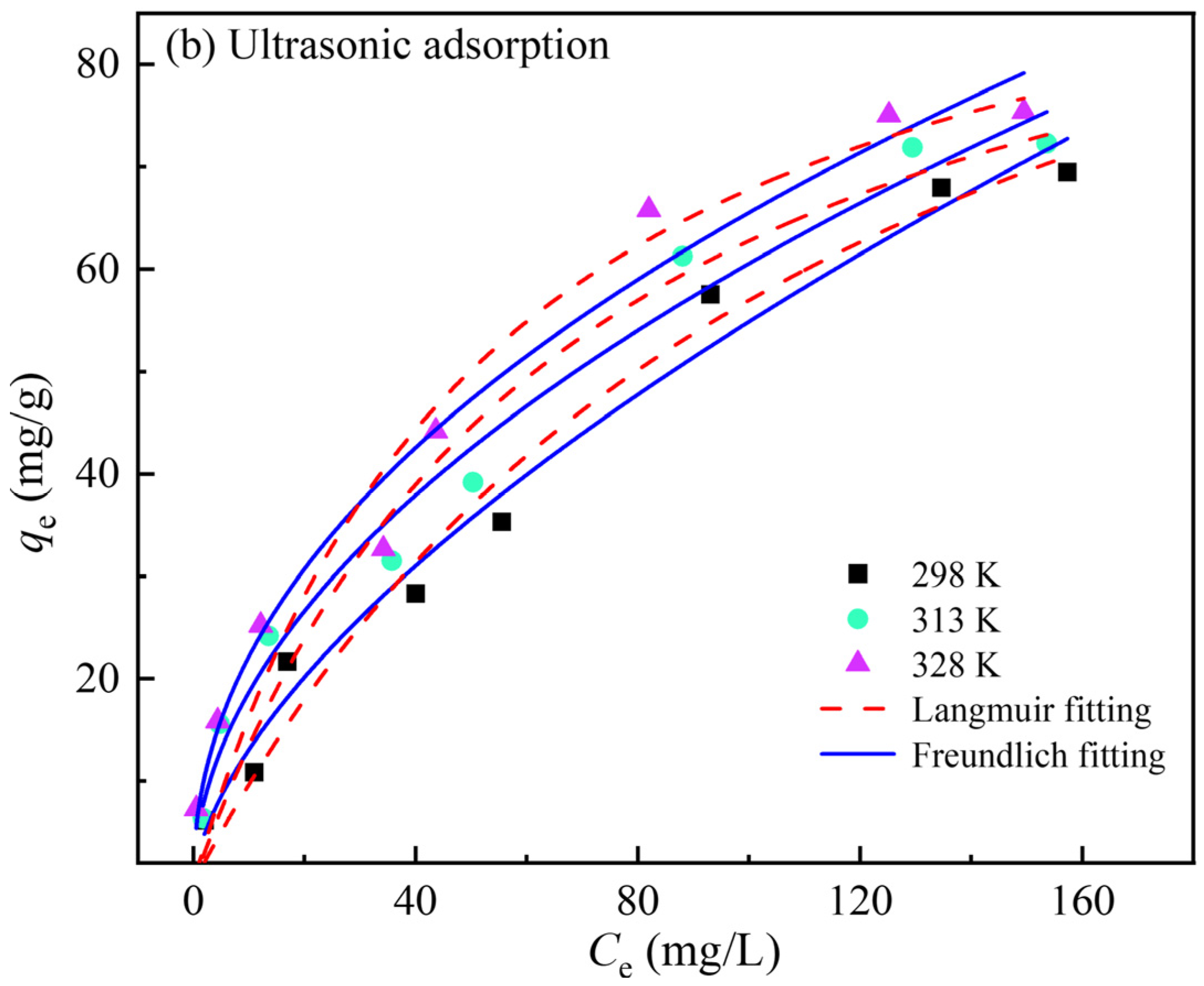
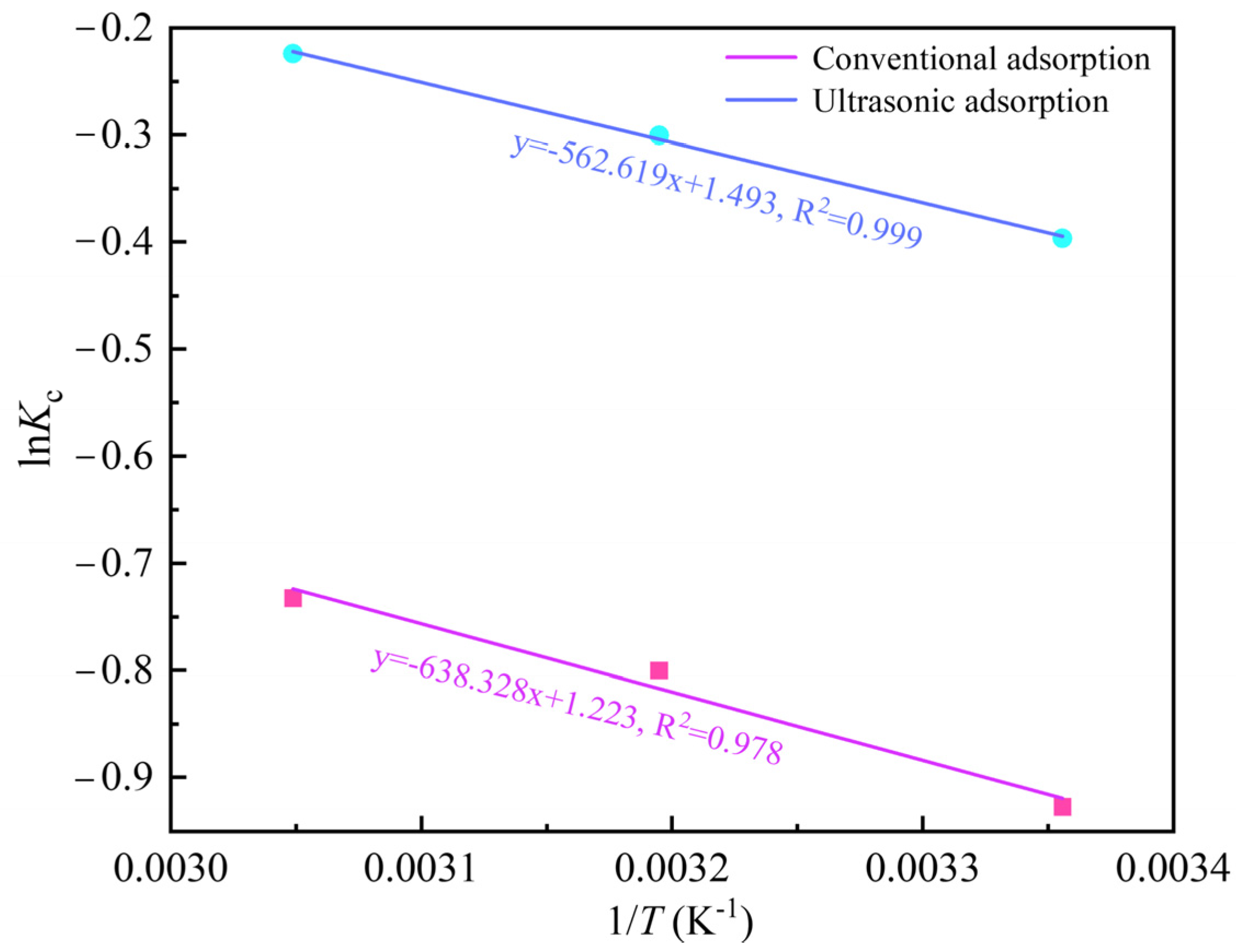
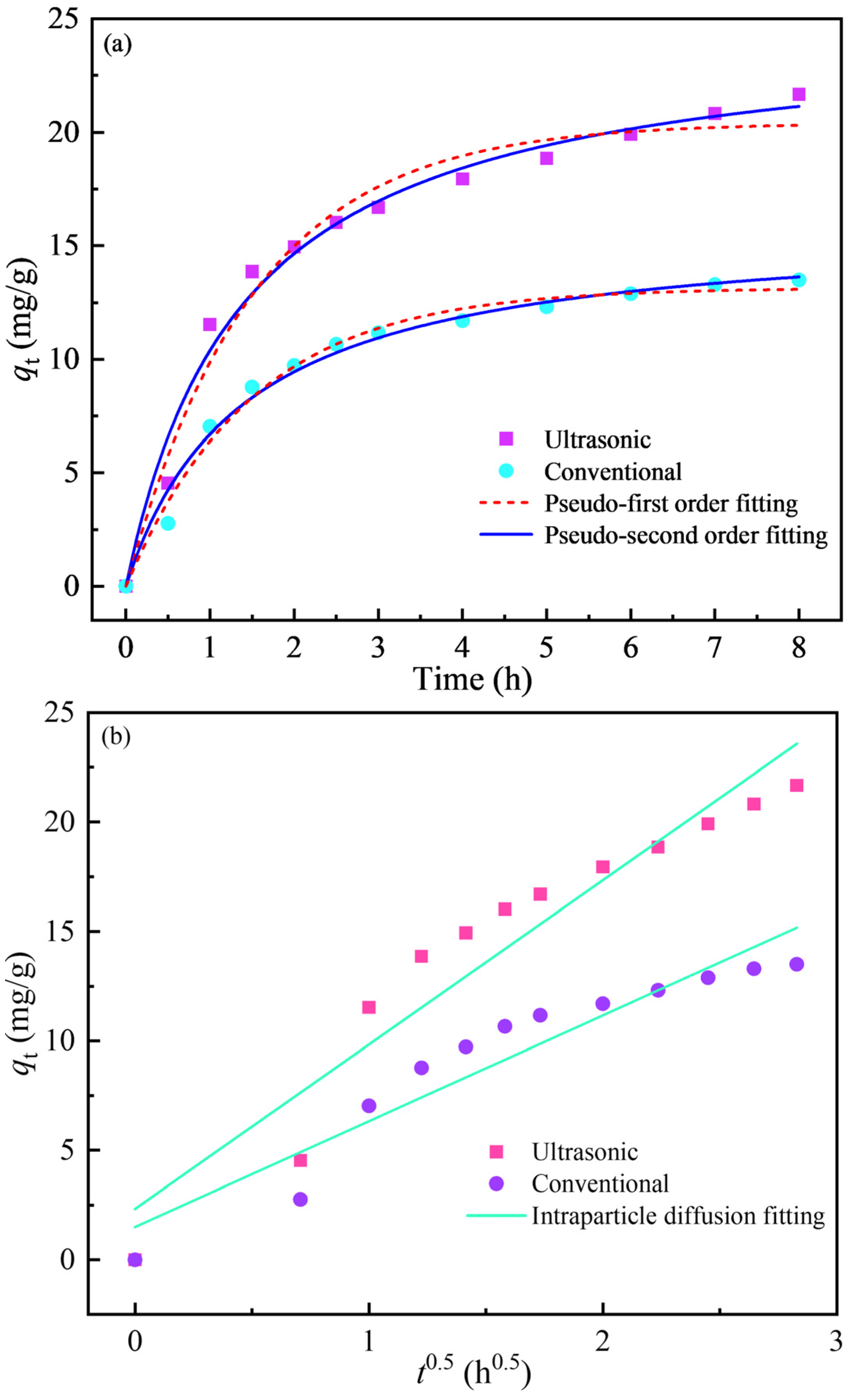


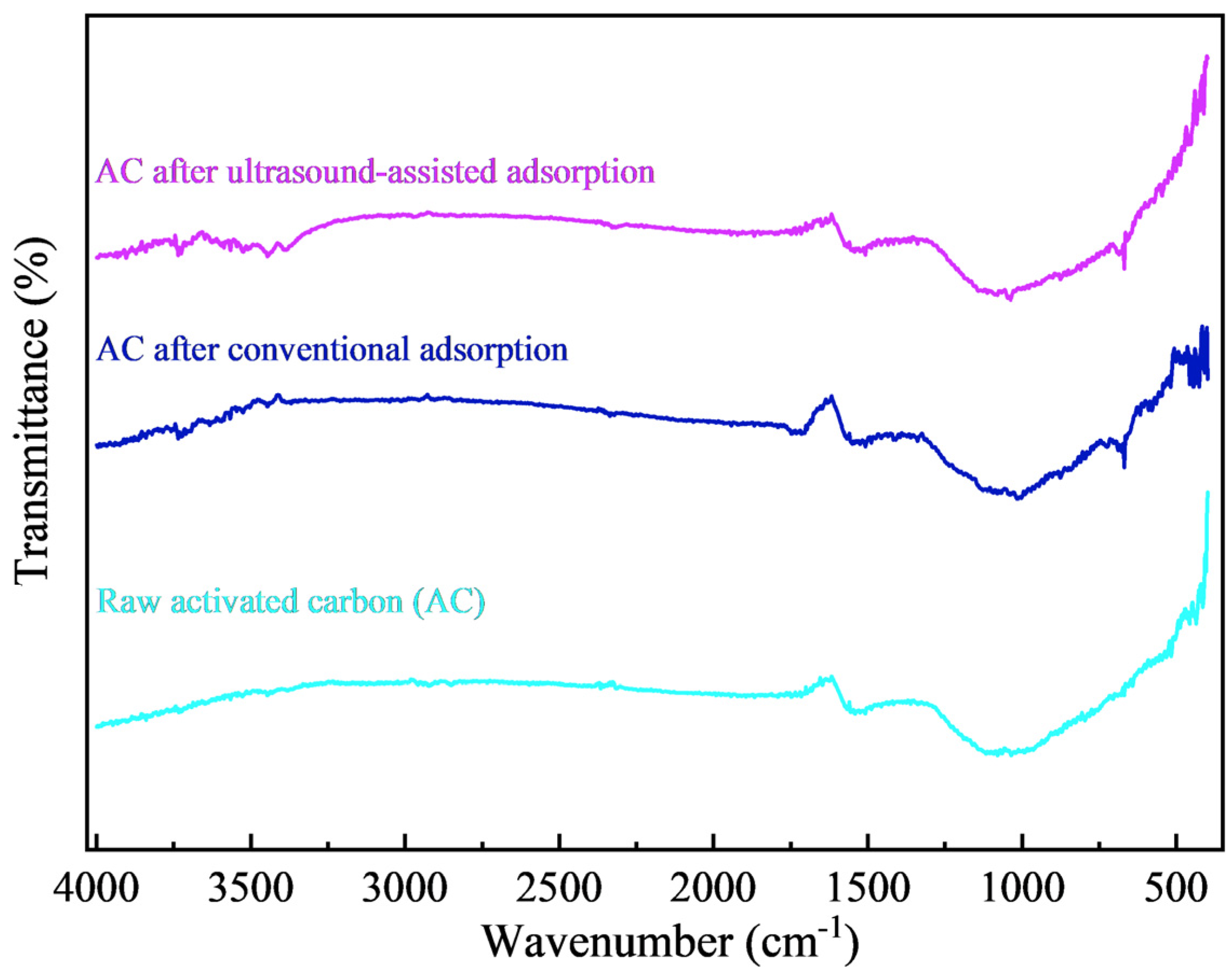
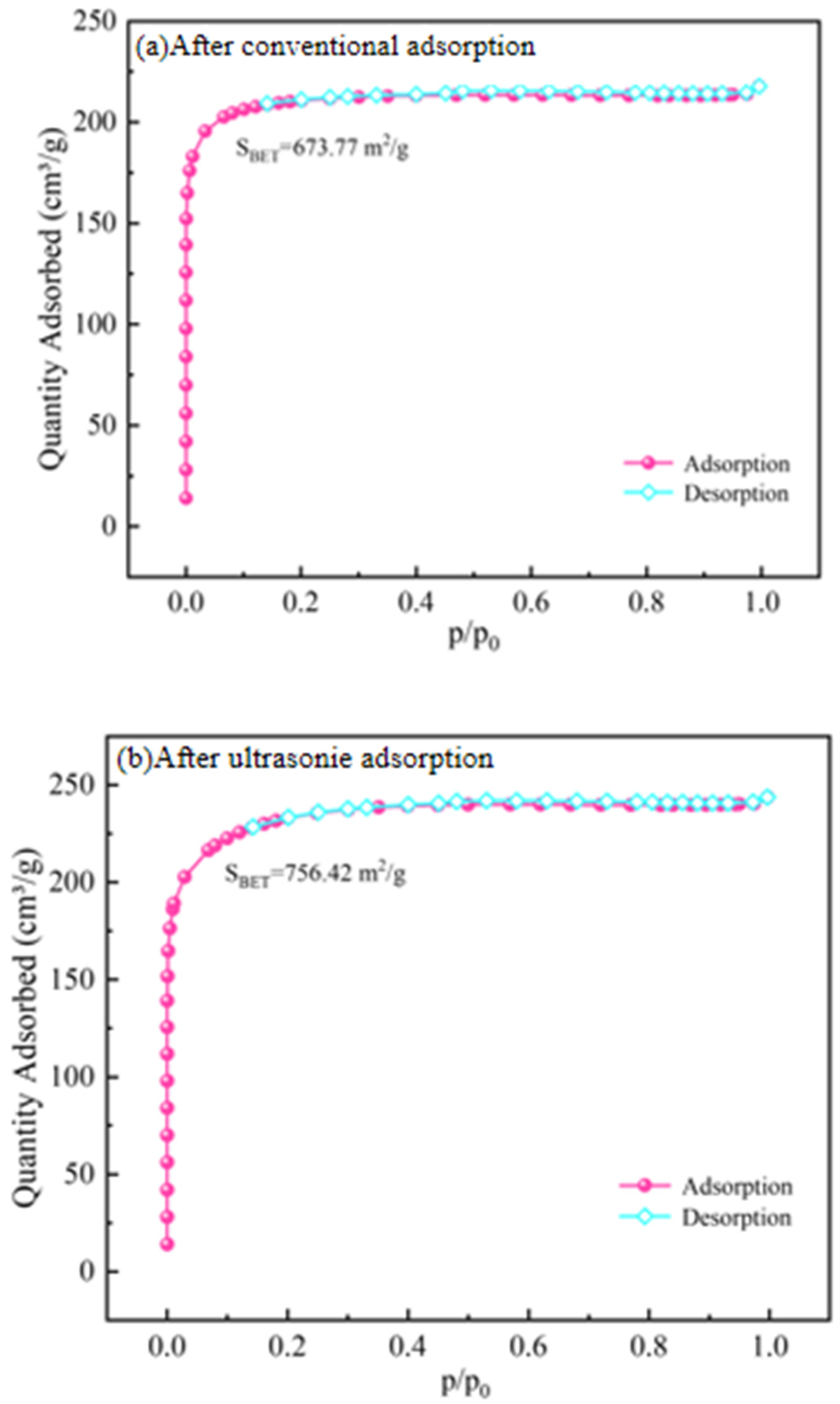
| Device | Power Output (W/cm2) | Frequency (kHz) | qe | ||
|---|---|---|---|---|---|
| Adsorption 2 h | Adsorption 4 h | Adsorption 6 h | |||
| Probe | 80 | 20 | 2.88 | 4.25 | 5.91 |
| Bath | 80 | 20 | 3.56 | 5.58 | 7.23 |
| T (K) | Langmuir Constants | Freundlich Constants | ||||
|---|---|---|---|---|---|---|
| qmax | B | R2 | k | n | R2 | |
| 298 | 108.373 | 0.005 | 0.985 | 1.353 | 1.443 | 0.993 |
| 313 | 100.431 | 0.006 | 0.974 | 1.939 | 1.560 | 0.985 |
| 328 | 80.249 | 0.013 | 0.967 | 3.944 | 1.923 | 0.968 |
| T (K) | Langmuir Constants | Freundlich Constants | ||||
|---|---|---|---|---|---|---|
| qmax | B | R2 | k | n | R2 | |
| 298 | 124.803 | 0.008 | 0.978 | 3.120 | 1.605 | 0.982 |
| 313 | 105.824 | 0.015 | 0.956 | 5.765 | 1.957 | 0.982 |
| 328 | 104.639 | 0.018 | 0.956 | 7.504 | 2.123 | 0.978 |
| Methods | 298 K | 313 K | 328 K |
|---|---|---|---|
| Conventional | 0.396 | 0.449 | 0.481 |
| Ultrasound-assisted | 0.673 | 0.740 | 0.799 |
| Methods | Temperature (K) | ∆Go (kJ.mol−1) | ∆Ho (kJ.mol−1) | ∆So (J mol−1.K−1) |
|---|---|---|---|---|
| Conventional | 298 | 2.298 | 5.307 | 10.164 |
| 313 | 2.082 | |||
| 328 | 1.997 | |||
| Ultrasound-assisted | 298 | 0.982 | 4.678 | 12.415 |
| 313 | 0.782 | |||
| 328 | 0.611 |
| Intensification Methods or Other Adsorbents | Adsorption Capacity (mg/g) | Ref. |
|---|---|---|
| Sulfur-impregnated activated carbon | 137.8 | [10] |
| Magnetic-activated carbon | 45.2 | [1] |
| Burnt acid-washed crab-shell | 10.0 | [24] |
| Hydrotalcite-type anionic clay | 60.0 | [25] |
| Chitosan–polyacrylamide graft copolymers | 10.2 | [26] |
| Dowex 21 K XLT resin | 32 | [27] |
| Coconut-shell activated carbon | 55.0 | This work |
| Ultrasound-assisted activated carbon adsorption | 75.4 | This work |
| Kinetic Models | Parameters | Value |
|---|---|---|
| Pseudo first-order model | qe (mg/g) | 20.42 |
| kf (min−1) | 0.661 | |
| R2 | 0.979 | |
| Pseudo second-order model | qe (mg/g) | 24.82 |
| ks (g/mmol/s) | 0.029 | |
| R2 | 0.984 | |
| Intraparticle diffusion model | ki (mg/g/min0.5) | 7.511 |
| C | 2.329 | |
| R2 | 0.918 |
| Kinetic Models | Parameters | Value |
|---|---|---|
| Pseudo first-order model | qe (mg/g) | 13.15 |
| kf (min−1) | 0.666 | |
| R2 | 0.989 | |
| Pseudo second-order model | qe (mg/g) | 16.00 |
| ks (g/mmol/s) | 0.045 | |
| R2 | 0.986 | |
| Intraparticle diffusion model | ki (mg/g/min0.5) | 4.837 |
| C | 1.498 | |
| R2 | 0.904 |
| Type | Surface Area (m2/g) | Average Pore Size (nm) | Total Pore Volume (cm3/g) |
|---|---|---|---|
| Raw activated carbon | 667.062 | 1.993 | 0.332 |
| After conventional adsorption | 673.766 | 1.995 | 0.336 |
| After ultrasonic adsorption | 756.420 | 1.989 | 0.376 |
| Adsorption Method | Particle Size Distribution (%) | ||||
| 1700~1180 | 1180~880 | 880~830 | 830~425 | <425 | |
| Conventional adsorption | 95.5 | 4.4 | 0.1 | ||
| Ultrasonic adsorption | 87.2 | 9.6 | 1.1 | 1.5 | 0.6 |
Disclaimer/Publisher’s Note: The statements, opinions and data contained in all publications are solely those of the individual author(s) and contributor(s) and not of MDPI and/or the editor(s). MDPI and/or the editor(s) disclaim responsibility for any injury to people or property resulting from any ideas, methods, instructions or products referred to in the content. |
© 2025 by the authors. Licensee MDPI, Basel, Switzerland. This article is an open access article distributed under the terms and conditions of the Creative Commons Attribution (CC BY) license (https://creativecommons.org/licenses/by/4.0/).
Share and Cite
Bai, Y.; Ge, H.; Li, Q.; Xie, F.; Wang, W. Ultrasound-Assisted Activated Carbon Adsorption Au(CN)2−. Materials 2025, 18, 1526. https://doi.org/10.3390/ma18071526
Bai Y, Ge H, Li Q, Xie F, Wang W. Ultrasound-Assisted Activated Carbon Adsorption Au(CN)2−. Materials. 2025; 18(7):1526. https://doi.org/10.3390/ma18071526
Chicago/Turabian StyleBai, Yunlong, Hui Ge, Qi Li, Feng Xie, and Wei Wang. 2025. "Ultrasound-Assisted Activated Carbon Adsorption Au(CN)2−" Materials 18, no. 7: 1526. https://doi.org/10.3390/ma18071526
APA StyleBai, Y., Ge, H., Li, Q., Xie, F., & Wang, W. (2025). Ultrasound-Assisted Activated Carbon Adsorption Au(CN)2−. Materials, 18(7), 1526. https://doi.org/10.3390/ma18071526





